1996 BUICK REGAL mirror
[x] Cancel search: mirrorPage 100 of 356

Illuminated Entry
Your courtesy lamps will come on and stay on for a set
time whenever you:
Pull a front door handle.
Press UNLOCK on the Remote Keyless Entry
Press DOOR on the Remote Keyless Entry
transmitter
(if equipped).
transmitter (if equipped).
If you open a door, the lamps will stay on while it’s open
and then turn
off automatically about 18 seconds after
you close it. If you don’t open
a door, the lamps will
turn
off after about 18 seconds, unless you pressed
UNLOCK
on the Remote Keyless Entry transmitter. If
you pressed UNLOCK and don’t open a door, the lamps
will turn off after about
55 seconds.
Illuminated entry includes a feature called theater
dimming. With theater dimming, the lamps don’t just
turn off at the end
of the delay time. Instead, they slowly
dim during the delay time until they go out. The delay
time is cancelled if you turn the ignition key to RUN or
START,
so the lamps will go out right away.
When the ignition
is on, illuminated entry is inactive,
which means the courtesy lamps won’t come on.
Rearview Mirror Reading Lamps
These lamps go on when you open the doors. When the
doors are closed, use
the switch next to each lamp to
turn them on and off.
ProCarManuals.com
Page 102 of 356
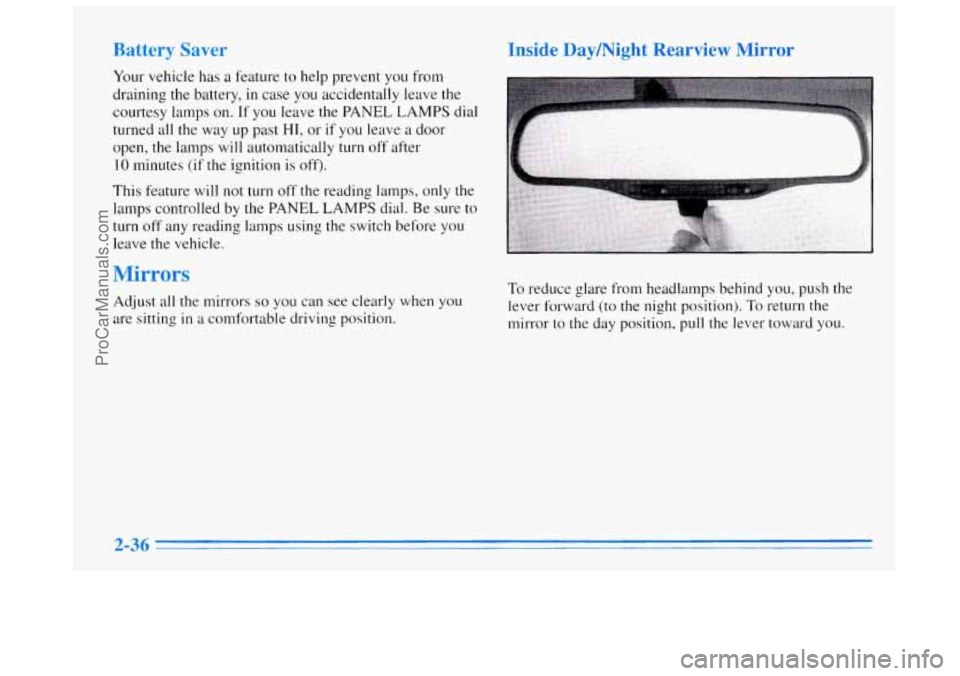
Battery Saver
Your vehicle has a feature to help prevent you from
draining the battery, in case you accidentally leave the
courtesy lamps on. If you leave the PANEL LAMPS dial
turned all the way up past
HI, or if you leave a door
open,
the lamps will automatically turn off after
10 minutes (if the ignition is oft).
This feature
will not turn off the reading lamps, only the
lamps controlled by the PANEL LAMPS dial. Be sure to
turn off any reading lamps using the switch before you
leave the vehicle.
Mirrors
Adjust all the mirrors so you can see clearly when you
are sitting
in a comfortable driving position.
Inside Daymight Rearview Mirror
- . ,~, ' /.. ,
To reduce glare from headlamps behind you, push the
lever forward (to the night position).
To return the
mirror to the day position,
pull the lever toward you.
2-36
ProCarManuals.com
Page 103 of 356
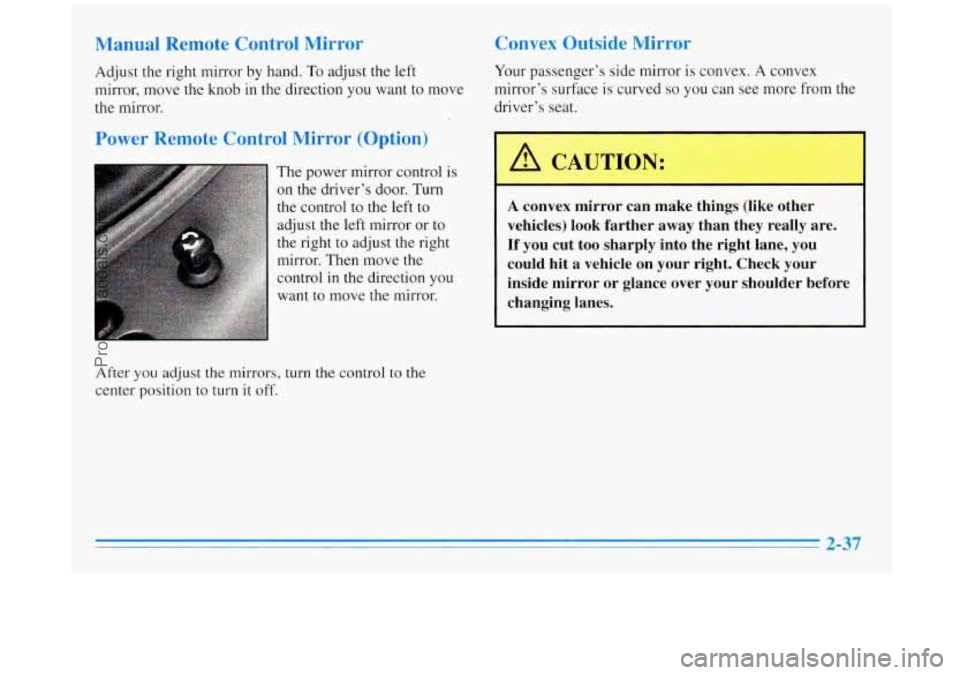
Manual Remote Control Mirror Convex Outside Mirror
Adjust the right mirror
by hand. To adjust the left Your
passenger's side mirror is convex. A convex
mirror, move the knob in the direction you want to move mirror's surface
is curved
so you can see more from the
the mirror. driver's seat.
Power Remote Control Mirror (Option)
The
power mirror control is
on the driver's door. Turn
the control
to the left to
adjust the left mirror or
to
the right to adjust the right
mirror. Then move
the
control in the direction you
want to move the mirror.
After
you adjust the mirrors, turn the control to the
center position to turn it off.
A CA"TI0h
A convex mirror can make things (like other
vehicles) look farther away than they really are.
If you cut too sharply into the right lane, you
could hit a vehicle
on your right. Check your
inside mirror or glance over your shoulder before
changing lanes.
2-37
ProCarManuals.com
Page 107 of 356
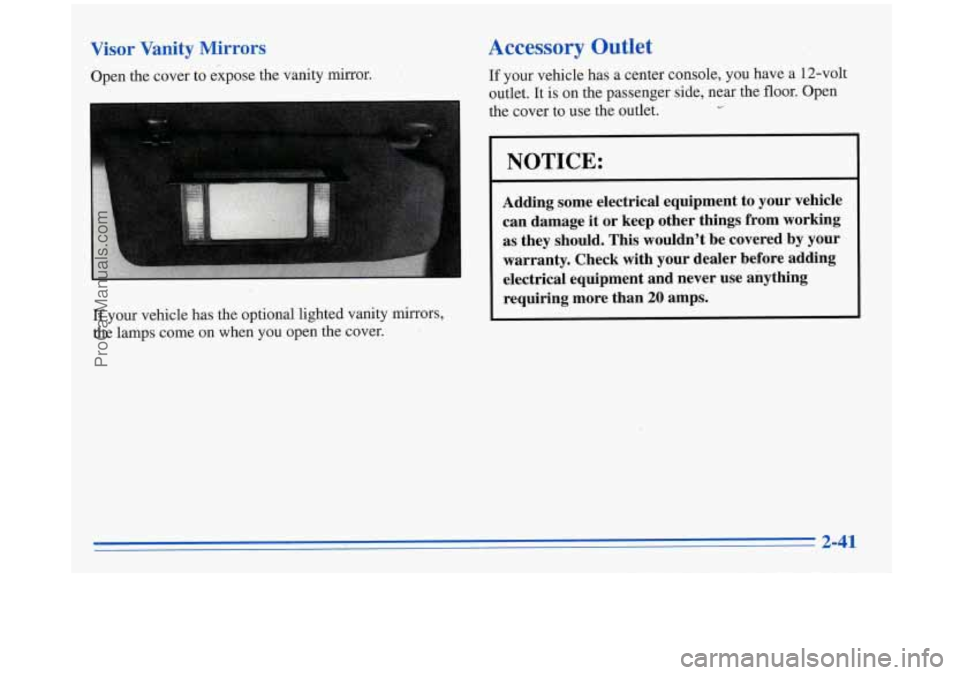
Visor Vanity Mirrors
Open the cover to expose the vanity mirror.
If your vehicle has the optional lighted vanity mirrors,
the lamps come on when you open the cover.
Accessory Outlet
If your vehicle has a center console, you have a 12-volt
outlet.
It is on the passenger side, near the floor. Open
the cover to use the outlet. -
NOTICE:
Adding some electrical .equipment to your vehicle
can damage it or keep other things from working
as they should. This wouldn’t be covered by your
warranty, Check with your dealer before adding electrical equipment and never use anything
requiring more than
20 amps.
__- 2-41
1. %
ProCarManuals.com
Page 164 of 356
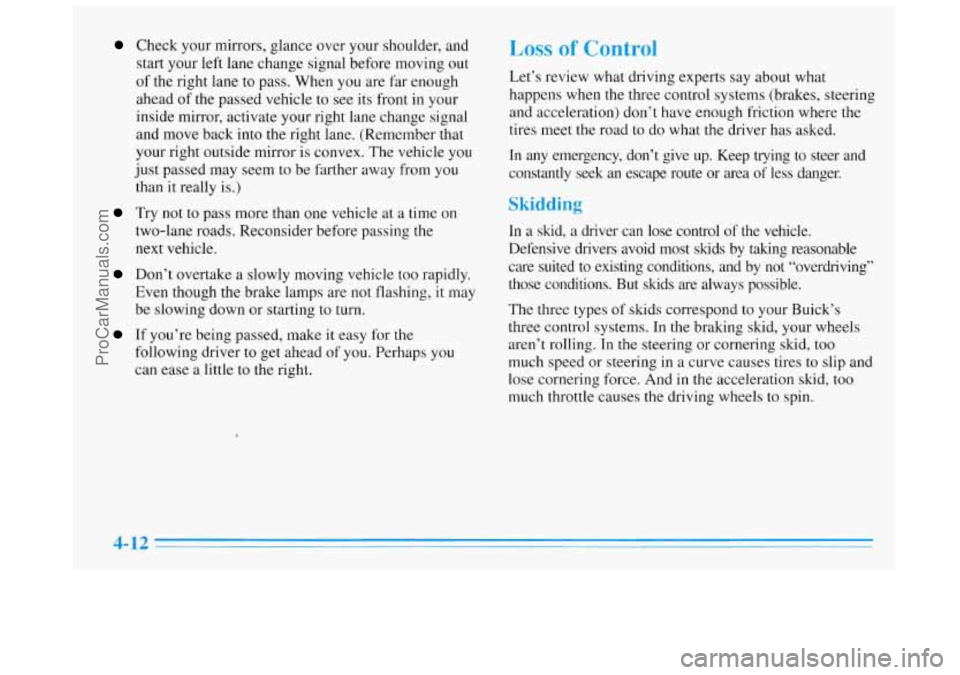
Check your mirrors, glance over your shoulder, and start your left lane change signal before moving
out
of the right lane to pass. When you are far enough
ahead of the passed vehicle to see its front
in your
inside mirror, activate your right lane change signal
and move back into the right lane. (Remember that
your right outside mirror is convex. The vehicle you
just passed may seem to be farther away from you
than it really is.)
Try not to pass more than one vehicle at a time on
two-lane roads. Reconsider before passing the
next vehicle.
Don’t overtake a slowly moving vehicle too rapidly.
Even though the brake lamps are not flashing, it
may
be slowing down or starting to turn.
If you’re being passed, make it easy for the
following driver to get ahead
of you. Perhaps you
can ease a little to the right.
Loss of Control
Let’s review what driving experts say about what
happens when the three control systems (brakes, steering
and acceleration) don’t have enough friction where the
tires meet the road to do what
the driver has asked.
In any emergency, don’t give up. Keep trying to steer and
constantly seek an escape route or area of less danger.
Skidding
In a skid, a driver can lose control of the vehicle.
Defensive drivers avoid most skids by taking reasonable
care suited to existing conditions, and by not “overdriving”
those conditions. But skids are always possible.
The three types of skids correspond to your Buick’s
three control systems. In the braking skid, your wheels
aren’t rolling. In the steering or cornering skid, too
much speed or steering in
a curve causes tires to slip and
lose cornering force. And
in the acceleration skid, too
much throttle causes the driving wheels to spin.
4- 12
ProCarManuals.com
Page 165 of 356
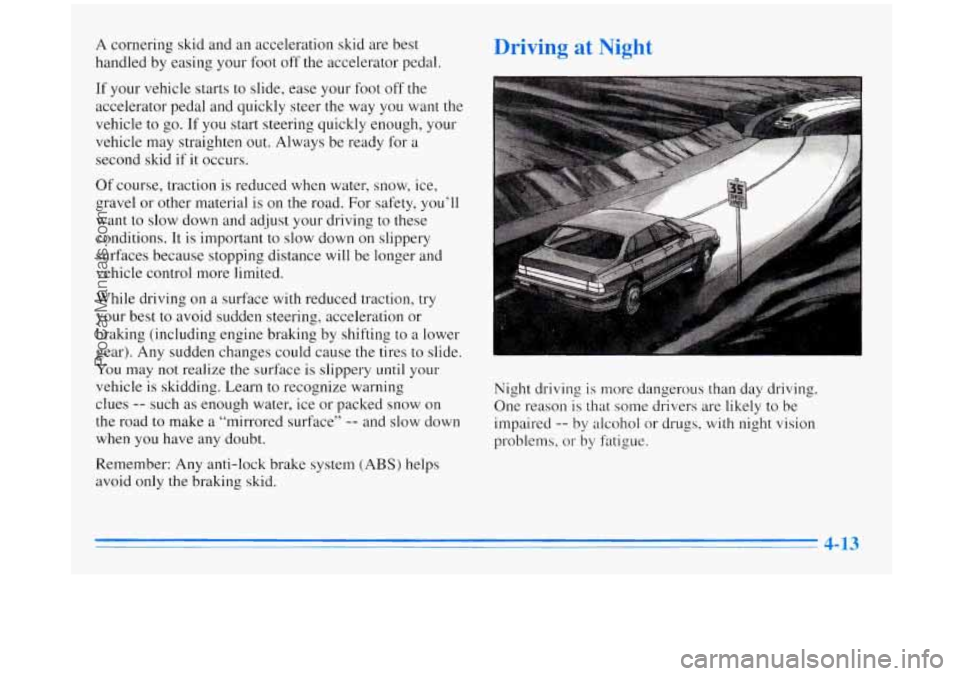
A cornering skid and an acceleration skid are best
handled by easing your foot off the accelerator pedal.
If your vehicle starts to slide, ease your foot
off the
accelerator pedal and quickly steer the way you want the
vehicle to go.
If you start steering quickly enough, your
vehicle may straighten out. Always be ready for a
second skid if it occurs.
Of course, traction
is reduced when water, snow, ice,
gravel or other material is on the road.
For safety, you’ll
want to slow down and adjust your driving to these
conditions.
It is important to slow down on slippery
surfaces because stopping distance will be longer and
vehicle control more limited.
While driving on
a surface with reduced traction, try
your best to avoid sudden steering, acceleration or
braking (including engine braking
by shifting to a lower
gear). Any sudden changes could cause the tires
to slide.
You may not realize the surface is slippery until your
vehicle is skidding. Learn to recognize warning
clues
-- such as enough water, ice or packed snow on
the road to make
a “mirrored surface” -- and slow down
when you have any doubt.
Remember: Any anti-lock brake system
(ABS) helps
avoid only
the braking skid.
DrivinP at Night
Night driving is more dangerous than day driving.
One reason
is that some drivers are likely to be
impaired
-- by alcohol or drugs, with night vision
problems, or by fatigue.
ProCarManuals.com
Page 166 of 356
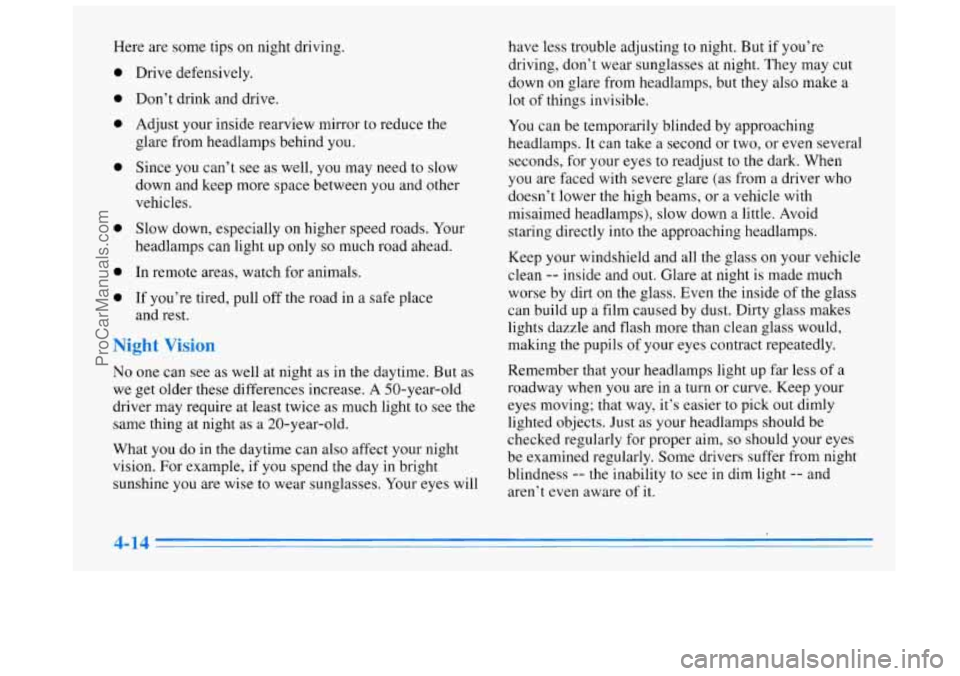
Here are some tips on night driving.
0
0
0
0
0
0
0
Drive defensively.
Don’t drink and drive.
Adjust your inside rearview mirror to reduce the
glare from headlamps behind you.
Since you can’t see as well, you may need to slow
down and keep more space between you and other
vehicles.
Slow down, especially on higher speed roads. Your
headlamps can light up only
so much road ahead.
In remote areas, watch for animals.
If you’re tired, pull
off the road in a safe place
and rest.
lrision
No one can see as well at night as in the daytime. But as
we get older these differences increase.
A 50-year-old
driver may require at least twice as much light to see the
same thing at night as a 20-year-old.
What you
do in the daytime can also affect your night
vision. For example, if you spend the day in bright
sunshine you are wise to wear sunglasses. Your eyes will have
less trouble adjusting to night. But if you’re
driving, don’t wear sunglasses at night. They may cut
down on glare from headlamps, but they also make a
lot of things invisible.
You can be temporarily blinded by approaching
headlamps. It can take a second or two, or
even several
seconds, for your eyes to readjust to the dark. When
you are faced with severe glare (as from a driver who
doesn’t lower the high beams, or a vehicle with
misaimed headlamps), slow down a little. Avoid
staring directly into the approaching headlamps.
Keep your windshield and all the glass on your vehicle
clean
-- inside and out. Glare at night is made much
worse by dirt on the glass. Even the inside of the glass
can build up a film caused by dust. Dirty glass makes
lights dazzle and flash more than clean glass would,
making the pupils of your eyes contract repeatedly.
Remember that your headlamps light up far less
of a
roadway when you are in a turn or curve. Keep your
eyes moving; that way, it’s easier to pick out dimly
lighted objects. Just as your headlamps should be
checked regularly for proper aim,
so should your eyes
be examined regularly. Some drivers suffer from night
blindness
-- the inability to see in dim light -- and
aren’t even aware of it.
ProCarManuals.com
Page 171 of 356
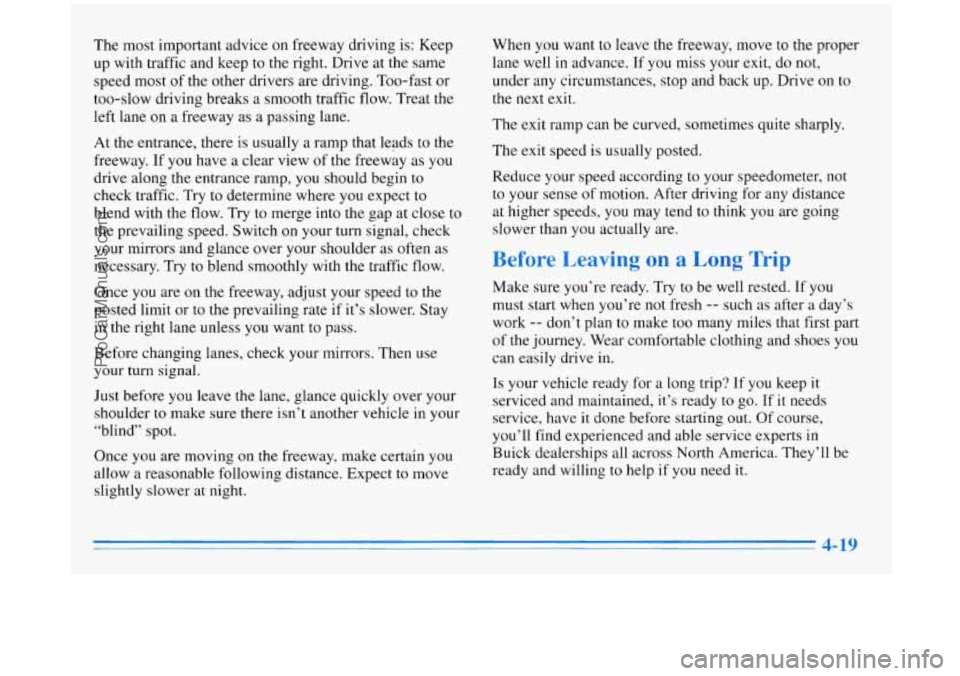
The most important advice on freeway driving is: Keep
up with traffic and keep to the right. Drive
at the same
speed most of the other drivers are driving. Too-fast or
too-slow driving breaks a smooth traffic flow. Treat the
left lane on a freeway as a passing lane.
At the entrance, there is usually a ramp that leads to the
freeway. If you have a clear view of the freeway as you
drive along the entrance ramp, you should begin to
check traffic.
Try to determine where you expect to
blend with the flow. Try to merge into the gap at close to
the prevailing speed. Switch on your turn signal, check
your mirrors and glance over your shoulder as often as
necessary. Try
to blend smoothly with the traffic flow.
Once you are on the freeway, adjust your speed to the
posted limit or to the prevailing rate
if it’s slower. Stay
in the right lane unless
you want to pass.
Before changing lanes, check your mirrors. Then use
your turn signal.
Just before you leave
the lane, glance quickly over your
shoulder to make sure there isn’t another vehicle
in your
“blind” spot.
Once you are moving
on the freeway, make certain you
allow a reasonable following distance. Expect to move
slightly slower at night. When
you want to leave the freeway, move to the proper
lane well
in advance. If you miss your exit, do not,
under
any circumstances, stop and back up. Drive on to
the
next exit.
The exit ramp can be curved, sometimes quite sharply.
The exit speed is usually posted.
Reduce your speed according to your speedometer, not
to your sense of motion. After driving for any distance
at higher speeds, you may tend to think you are going
slower than you actually are.
Before Leaving on a - l--b __ - 1-
Make sure you’re ready. Try to be well rested. If you
must start when you’re not fresh
-- such as after a day’s
work
-- don’t plan to make too many miles that first part
of the journey. Wear comfortable clothing and shoes you
can easily drive in.
Is your vehicle ready for a long trip? If you keep it
serviced and maintained, it’s ready
to go. If it needs
service, have it done before starting
out. Of course,
you’ll find experienced and able service experts in
Buick dealerships all across North America. They’ll be
ready and willing to help if you need it.
ProCarManuals.com